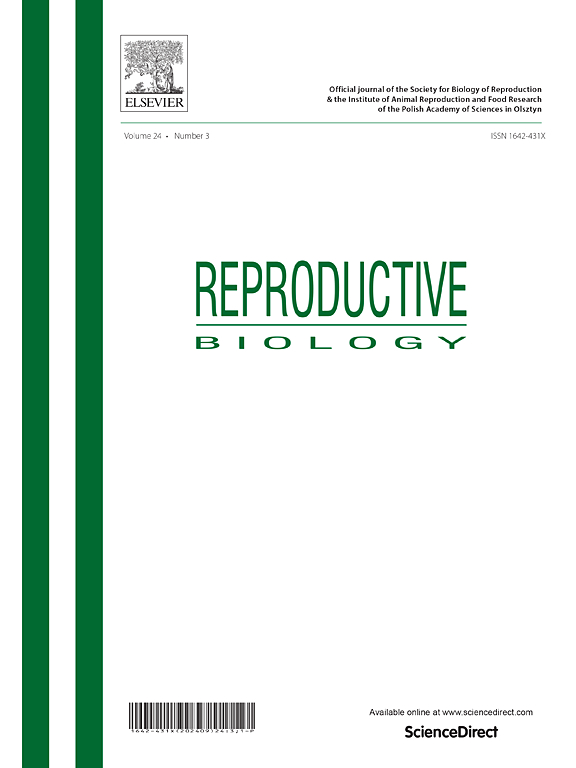慢性应激干扰雄性大鼠生殖和生育的神经内分泌控制
IF 2.5
3区 生物学
Q3 REPRODUCTIVE BIOLOGY
引用次数: 0
摘要
目前,压力被认为是男性不育的危险因素之一,它会改变精子的功能。精子的产生和成熟取决于下丘脑-垂体-睾丸轴的控制。因此,本研究的目的是评估慢性应激对男性生殖神经内分泌控制、附睾氧化状态和男性生育能力的影响。将成年雄性大鼠分为对照组和慢性应激组。长期应激雄鼠连续50天浸泡在冷水中。安乐死后解剖下丘脑进行Kisspeptin (Kiss1)和促性腺激素释放激素(GnRH)评估;测定血清黄体生成素(LH)、睾酮(T)和皮质酮浓度。测定附睾中活性氧(ROS)、脂质过氧化物以及超氧化物歧化酶(SOD)、过氧化氢酶(CAT)和谷胱甘肽过氧化物酶(GPx4)的含量。评估精子活力、活力、浓度、形态和顶体反应。用完整雌鼠附睾精子与卵母细胞进行体外受精。应激雄性下丘脑Kiss1和GnRH含量降低,LH和T浓度降低,血清皮质酮浓度升高。慢性应激后附睾各区域ROS和脂质过氧化物含量均升高,SOD、CAT和GPx4含量降低;精子质量也较低。与对照组相比,受精卵的百分比下降,胚胎发育较低。总之,这些结果表明,慢性应激破坏了男性生殖的神经内分泌控制,并在附睾中产生氧化应激。这些影响会影响精子质量,导致受精率低和胚胎发育不良。本文章由计算机程序翻译,如有差异,请以英文原文为准。
Chronic stress disturbs neuroendocrine control of reproduction and fertility in male rats
Currently, stress is considered one of the risk factors for infertility in male humans, altering sperm function. Sperm production and maturation depends on the hypothalamic-pituitary-testis axis control. Therefore, the objective of the current study was to evaluate the effects of chronic stress on the neuroendocrine control of male reproduction, the oxidative status in the epididymis, and male fertility. Adult male rats were assigned to control or chronic stress groups. Chronically stressed males were exposed to cold-water immersion (CWI) for 50 consecutive days. After euthanasia, the hypothalamus was dissected for Kisspeptin (Kiss1) and Gonadotropin releasing hormone (GnRH) evaluation; serum luteinizing hormone (LH), testosterone (T), and corticosterone concentrations were determined. In the epididymis, reactive oxygen species (ROS), lipid peroxides, and content of superoxide dismutase (SOD), catalase (CAT), and glutathione peroxidase (GPx4) were assessed. Sperm motility, viability, concentration, morphology and acrosomal reaction were assessed. Epididymal sperm were used for in-vitro fertilization with oocytes from intact female rats. Stressed males showed lower hypothalamic Kiss1 and GnRH content, lower LH and T concentration, together with higher serum corticosterone concentration. ROS production, and lipid peroxides increased in all epididymal regions, while SOD, CAT, and GPx4 content decreased after chronic stress; sperm quality was also lower. The percentage of fertilized oocytes decreased, and embryonic development was low, compared to controls. Together, these results show that chronic stress disrupts neuroendocrine control of male reproduction and generates oxidative stress in the epididymis. These effects disturb sperm quality, leading to low fertilizing potential and poor embryonic development.
求助全文
通过发布文献求助,成功后即可免费获取论文全文。
去求助
来源期刊

Reproductive biology
生物-生殖生物学
CiteScore
3.90
自引率
0.00%
发文量
95
审稿时长
29 days
期刊介绍:
An official journal of the Society for Biology of Reproduction and the Institute of Animal Reproduction and Food Research of Polish Academy of Sciences in Olsztyn, Poland.
Reproductive Biology is an international, peer-reviewed journal covering all aspects of reproduction in vertebrates. The journal invites original research papers, short communications, review articles and commentaries dealing with reproductive physiology, endocrinology, immunology, molecular and cellular biology, receptor studies, animal breeding as well as andrology, embryology, infertility, assisted reproduction and contraception. Papers from both basic and clinical research will be considered.
 求助内容:
求助内容: 应助结果提醒方式:
应助结果提醒方式:


